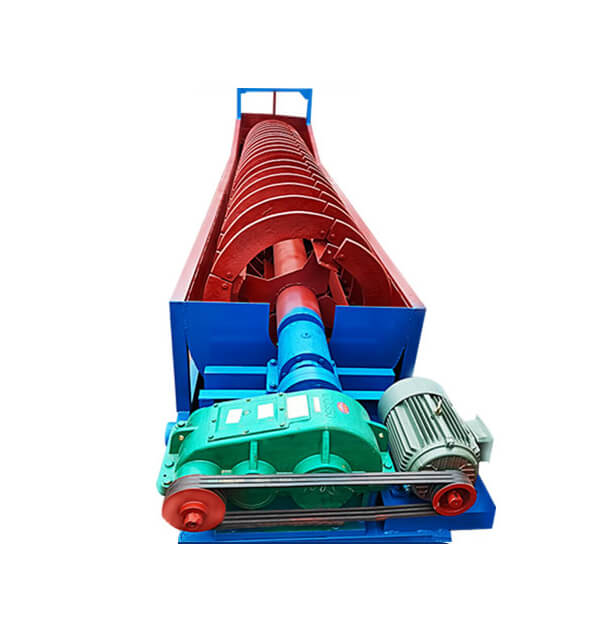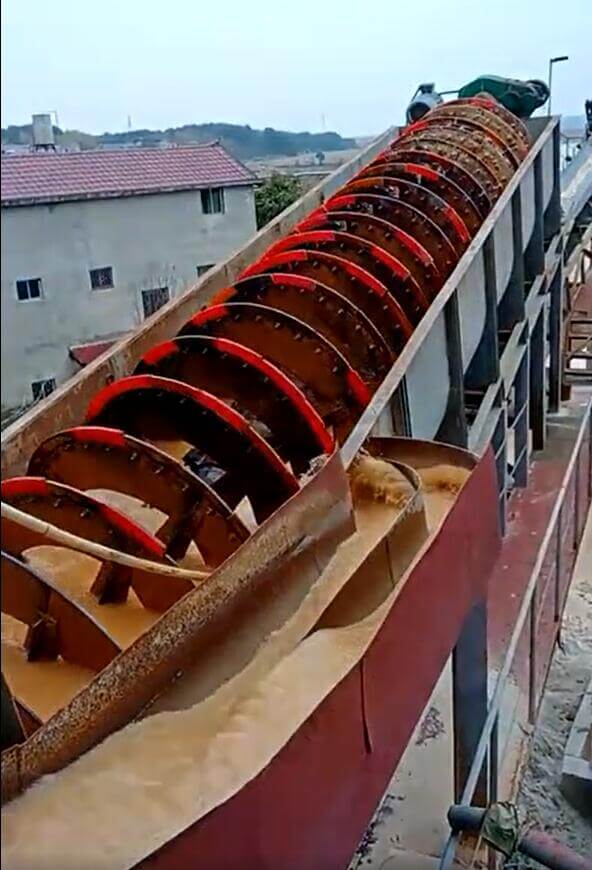The spiral classifier is one of the important equipment in the mineral processing process. Its principle is to use the difference in the settling speed of solid particles in the liquid to classify materials. The classification effect of the spiral classifier will directly affect the content of qualified products in the returned sand, thus affecting the grinding effect.
During the classification process, the factors that affect the classification effect of the spiral classifier mainly include the following three aspects:
- The properties of the ore: The mud content and particle size of the materials fed into the classifier constitute the specific gravity and shape of the ore.
- Factors in machine construction: The inclination angle of the trough, the rotation speed of the screw, shaft, and the width of the trough.
- Operational factors: Slurry concentration, ore feeding volume and uniformity, and the height of the overflow weir.

Ore Properties
- The material in the classifier contains a lot of mud or fine particles.
When the graded material contains more mud or fine particles, the viscosity of the slurry will be greater, and the sedimentation speed of the ore particles in the slurry will be smaller, so the particle size of the overflow product will be coarser. In this case, to ensure that the particle size in the overflow product meets the requirements, we should appropriately reduce the particle slurry concentration. If the material contains little mud or has undergone desliming treatment, appropriately increase the classification concentration, to avoid excessive fine particles being entrained in the returned sand.
- The specific gravity of classified materials and the shape of ore particles are different.
Under the same concentration and other operating conditions, if the specific gravity of the classified material is smaller, the viscosity of the slurry will be greater. At this time, the particle size in the overflow product will become coarser, and the fine-grained content in the returned sand will increase. Therefore, when grading ores with large specific gravity, the classification concentration should be appropriately increased; when grading ores with small specific gravity, the classification concentration should be appropriately reduced.
When the ore particles are flat in shape, their settling speed is slower than that of round or nearly round ores, so the classification concentration of flat ores should be lower, or the discharge speed of overflow products should be accelerated.
Machine Construction
- Classifier trough inclination
The inclination of the classifier trough affects the settlement area of the classifier. However, since the spiral classifier trough is fixed after installation, the inclination of the classifier trough needs to be adjusted to an appropriate angle during installation. Generally speaking, the appropriate installation angle of the grader is between 16-18°.If the inclination angle is too large, the settling area will be reduced, coarse-grained materials will easily slide down, and the overflow particle size will become coarser, but the fine-grained materials in the returned sand will also decrease accordingly; conversely, if the inclination angle is too small, the settling area will be large, the overflow particle size will be fine, and the returned sand will Medium and fine-grained materials will also increase. Therefore, when designing the plant selection, the inclination angle needs to be comprehensively determined based on the nature of the material, the classification fineness, and other factors.
- Spiral rotation speed
The number of revolutions of the spiral should be sufficient to transport the settled coarse particles. The faster the speed of the spiral shaft of the classifier, the stronger the stirring effect on the slurry, and the more coarse particles will be entrained in the overflow product. To obtain a thicker overflow and process materials with heavy specific gravity and rapid settling, the number of revolutions of the spiral can be appropriately increased, but it cannot be too large to avoid destroying the classification effect. However, slow the spiral speed down as much as possible for the classifier used in the second-stage grinding or fine-grinding cycle.In summary, lower rotational speeds are generally used in spiral classifiers, especially for large spiral classifiers. For example, to obtain coarse overflow, the speed of a spiral with a diameter of two meters should not exceed 6 rpm. Generally, the speed of a spiral with a diameter of more than one meter should be controlled at 2-8 rpm.
- Slurry concentration
If the pulp concentration is small, the viscosity of the pulp will also decrease. Therefore, the sedimentation speed of the ore particles is also accelerated, and the particle size of the overflow product obtained is finer. On the contrary, the particle size of the overflow product is coarser.However, it should be pointed out that when the concentration of the slurry is reduced to a certain level if the concentration continues to decrease, the particle size of the overflow product will become coarser. The main reason is that when the concentration decreases a lot, the volume of the slurry (or the amount of slurry) is also very large, so the slurry flow rate (ascending flow rate and horizontal flow rate) in the classifier also increases. Therefore, coarser mineral particles are also washed into the overflow product. So the slurry concentration must be reasonably controlled according to regulations.
Operation
- Slurry concentration, Ore feeding amount & Uniformity
When the concentration of the slurry is constant, if the amount of ore fed into the classifier increases, the flow rate of the slurry will also increase, thus making the overflow product particle size coarser. As the ore volume decreases, the particle size of the overflow product becomes finer, and at the same time, the fine particle content in the returned sand also increases.
Therefore, the ore feeding amount of the classifier should be appropriate. In particular, the ore feed should be uniform and not fluctuate from large to small. The smaller the fluctuation range, the better. So that the classifier can work under normal processing conditions and obtain good classification results.
- Height of overflow weir
When the overflow weir is raised, the settling area of mineral particles can be increased. At the same time, as the slurry surface rises, the stirring effect of the spiral on the slurry surface also weakens, which makes the overflow particle size finer. On the contrary, lowering the overflow weir will make the overflow granularity coarser.
The classification effect of the spiral classifier involves many aspects. When you buy a classifier, we recommend: Choosing a regular mineral processing equipment manufacturer to purchase a spiral classifier to ensure the quality of the equipment; in daily production, spiral classifier operators must pay more attention, calmly analyze abnormal situations, and take corresponding solutions to ensure the smooth operation of the spiral classifier and obtain good classification results.

